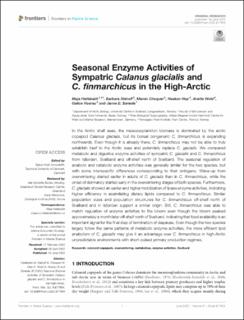| dc.contributor.author | Hatlebakk, Maja K Viddal | |
| dc.contributor.author | Niehoff, Barbara | |
| dc.contributor.author | Choquet, Marvin | |
| dc.contributor.author | Hop, Haakon | |
| dc.contributor.author | Wold, Anette | |
| dc.contributor.author | Hoarau, Galice Guillaume | |
| dc.contributor.author | Søreide, Janne | |
| dc.date.accessioned | 2022-11-15T13:00:32Z | |
| dc.date.available | 2022-11-15T13:00:32Z | |
| dc.date.created | 2022-09-08T13:23:21Z | |
| dc.date.issued | 2022 | |
| dc.identifier.citation | Hatlebakk, M. K. V., Niehoff, B., Choquet, M., Hop, H., Wold, A., Hoarau, G. G. & Søreide, J. (2022). Seasonal Enzyme Activities of Sympatric Calanus glacialis and C. finmarchicus in the High-Arctic. Frontiers in Marine Science, 9: 877904. doi: | en_US |
| dc.identifier.issn | 2296-7745 | |
| dc.identifier.uri | https://hdl.handle.net/11250/3031929 | |
| dc.description.abstract | In the Arctic shelf seas, the mesozooplankton biomass is dominated by the arctic copepod Calanus glacialis, but its boreal congeneric C. finmarchicus is expanding northwards. Even though it is already there, C. finmarchicus may not be able to truly establish itself in the Arctic seas and potentially replace C. glacialis. We compared metabolic and digestive enzyme activities of sympatric C. glacialis and C. finmarchicus from Isfjorden, Svalbard and off-shelf north of Svalbard. The seasonal regulation of anabolic and catabolic enzyme activities was generally similar for the two species, but with some interspecific differences corresponding to their ontogeny. Wake-up from overwintering started earlier in adults of C. glacialis than in C. finmarchicus, while the onset of dormancy started early in the overwintering stages of both species. Furthermore, C. glacialis showed an earlier and higher mobilization of lipase enzyme activities, indicating higher efficiency in assimilating dietary lipids compared to C. finmarchicus. Similar population sizes and population structures for C. finmarchicus off-shelf north of Svalbard and in Isfjorden support a similar origin. Still, C. finmarchicus was able to match regulation of enzyme activities to the bloom even though the bloom peaked approximately a month later off-shelf north of Svalbard, indicating that food availability is an important signal for the final step of termination of diapause. Even though the two species largely follow the same patterns of metabolic enzyme activities, the more efficient lipid anabolism of C. glacialis may give it an advantage over C. finmarchicus in high-Arctic unpredictable environments with short-pulsed primary production regimes. | en_US |
| dc.language.iso | eng | en_US |
| dc.rights | Navngivelse 4.0 Internasjonal | * |
| dc.rights.uri | http://creativecommons.org/licenses/by/4.0/deed.no | * |
| dc.title | Seasonal Enzyme Activities of Sympatric Calanus glacialis and C. finmarchicus in the High-Arctic | en_US |
| dc.title.alternative | Seasonal Enzyme Activities of Sympatric Calanus glacialis and C. finmarchicus in the High-Arctic | en_US |
| dc.type | Peer reviewed | en_US |
| dc.type | Journal article | en_US |
| dc.description.version | publishedVersion | en_US |
| dc.rights.holder | © 2022 The Author(s) | en_US |
| dc.subject.nsi | VDP::Matematikk og Naturvitenskap: 400::Zoologiske og botaniske fag: 480::Marinbiologi: 497 | en_US |
| dc.subject.nsi | VDP::Matematikk og Naturvitenskap: 400::Zoologiske og botaniske fag: 480::Økologi: 488 | en_US |
| dc.source.pagenumber | 13 | en_US |
| dc.source.volume | 9 | en_US |
| dc.source.journal | Frontiers in Marine Science | en_US |
| dc.identifier.doi | 10.3389/fmars.2022.877904 | |
| dc.identifier.cristin | 2049930 | |
| dc.relation.project | Norges forskningsråd: 24464 | en_US |
| dc.source.articlenumber | 877904 | en_US |

